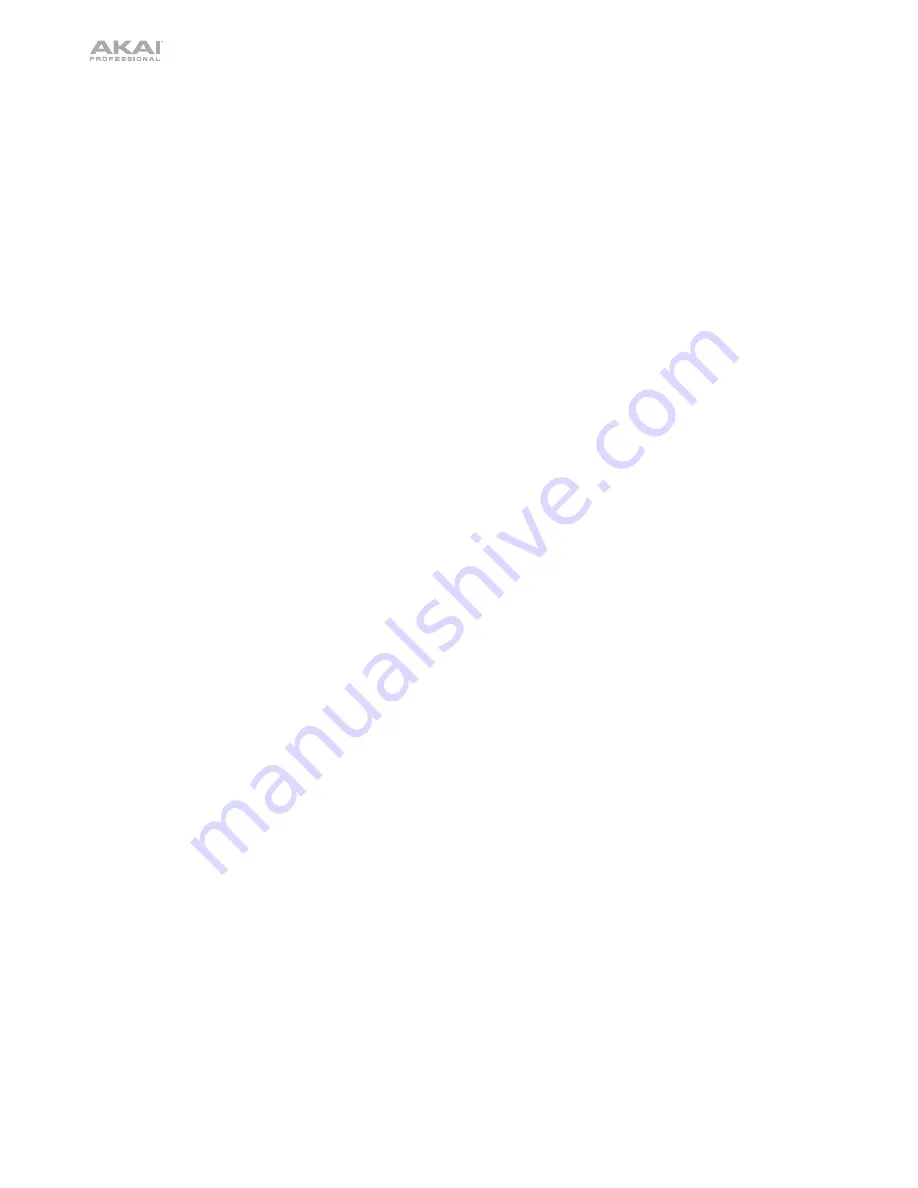
6
Mode & View Controls
21.
Menu:
Press this button to open the Menu where you can select any of the available modes. Tap an option to
enter that mode.
22.
Main
/
Track:
Press this button to view Main Mode, an overview of the most-used functions.
Press and hold
Shift
and press this button to view Track View Mode, an overview of the tracks of each sequence.
23.
Browse
/
Save:
Press this button to view the Browser. The Browser lets you navigate your computer’s internal
and external hard disks to load samples, sequences, songs, etc. Using filter buttons and user-definable folders,
you can easily adapt it to your workflow. You can also preview samples before loading them.
Press and hold
Shift
and press this button to save the current project (including its samples, programs,
sequences, and songs).
24.
Step Seq
/
List Edit:
Press this button to view the Step Sequencer where you can create or edit sequences by
using the pads as “step buttons,” simulating the experience of a traditional step-sequencer-style drum machine.
Press and hold
Shift
and press this button to view your sequences using the List Edit View instead of Grid View.
25.
Sampler
/
Looper:
Press this button to view the Sampler where you can record audio samples to use in your projects.
Press and hold
Shift
and press this button to view the Looper where you can record and overdub audio in real
time—a great tool for live performance as well as spontaneous moments in the studio. You can export the loop
as a sample to use in your project.
26.
XYFX:
Press this button to view XYFX Mode, which turns the touchscreen into an XY pad where each axis
represents the range of an effect parameter. As you move touch or move your finger on the touchscreen, the
current position will determine the current value of the two parameters. You can use this mode to create
interesting effect automation on your tracks.
27.
Pad Perform:
Press this button to view Pad Perform Mode where you can assign musical scales/modes, chords,
or progressions to the pads for creative performance options.
28.
Prog Edit:
Press this button to view Program Edit Mode, which contains all parameters for editing your programs.
29.
Sample Edit:
Press this button to view Sample Edit Mode where you can edit your samples using various
functions and processes.
30.
Pad Mixer:
Press this button to view the Pad Mixer where you can set a program’s levels, stereo panning,
routing, and effects.
31.
Ch. Mixer:
Press this button to view the Channel Mixer where you can set levels, stereo panning, and other
settings for your tracks, programs, returns, submixes, and masters.
32.
Track Mute
/
Pad Mute:
Press this button to view Track Mute Mode where you can easily mute tracks within a
sequence or set mute groups for each track.
Press and hold
Shift
and press this button to view Pad Mute Mode where you can easily mute pads within a
program or set mute groups for each pad within a program.
33.
Next Seq
/
Song:
Press this button to view Next Sequence Mode where you can trigger different sequences simply
by playing the pads. This is useful for live performances, letting you change a song’s structure in real time.
Press and hold
Shift
and press this button to view Song Mode where you can arrange sequences in a specific order
and/or repetition to create songs. You can edit the structure of a song during playback for easy, on-the-fly composing.
Transport & Recording Controls
34.
Play:
Press this button to play the sequence from the audio pointer’s current position.
35.
Play Start:
Press this button to play the sequence from its start point.
36.
Stop:
Press this button to stop playback.
37.
Rec:
Press this button to record-arm the sequence. Press
Play
or
Play Start
to start recording. Recording in this
way (rather than using
Overdub
) erases the events of the current sequence. After the sequence plays through
once while recording, Overdub will be enabled.
38.
Overdub:
Press this button to enable Overdub, which allows you to record note events in a sequence without
overwriting any previously recorded note events. You can enable Overdub either before or during recording.
Содержание MPCX
Страница 1: ...Quickstart Guide English 2 11 ...
Страница 12: ...Compliance Draft 1 0 ...












